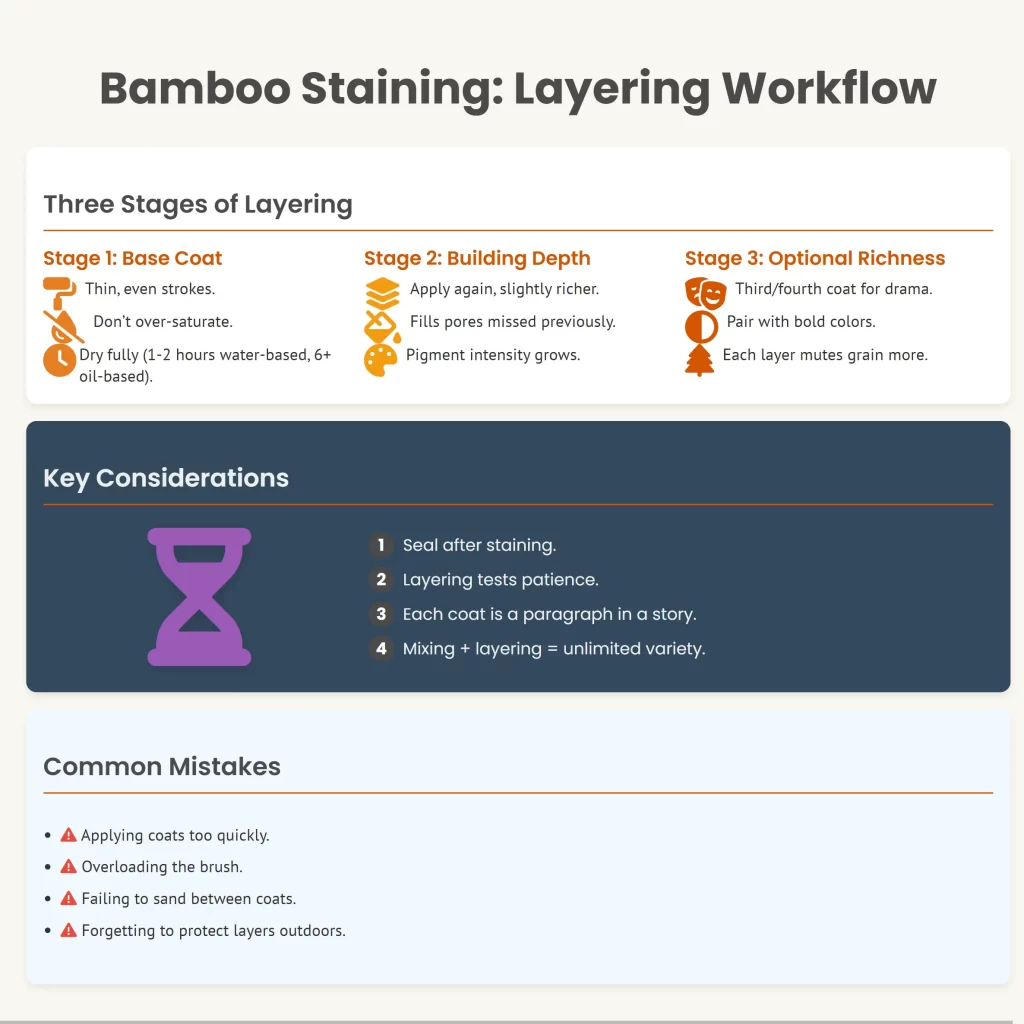This post may contain affiliate links, which means I may receive a commission for purchases made through the links. I will only recommend products that I have personally used! Learn more on my Disclosure page!
Bamboo has a rhythm in its fibers, steady, repeating, ancient. Stain adds color, yes. But a single coat often feels flat, like a song missing harmony. Apply layers, however, and something changes. The furniture begins to sing in depth and richness, as if tone upon tone created harmony between wood and light.
If you’d like the full repertoire, layering, mixing, sealing, and even rescuing old bamboo furniture, the answers live inside The Bamboo Staining Bible. Consider layering not just technique, but craft, and let the guide walk you hand‑in‑hand.
And if sanding hasn’t been your first step yet, connect back to how to sand bamboo furniture properly. Smooth surfaces decide how each stain layer clings.
Why layer?
One coat of stain produces coverage. Two or three build contrast, body, and warmth. Bamboo responds especially well to layering because its outer skin is dense. The fibers accept thin coats unevenly if rushed, but with repeated delicacy, they deepen into radiant tones that feel alive.
Layering also slows fade. Colors resist UV longer when pigment carries through multiple surfaces, especially if sealed.
Table: Impact of Layering Bamboo Stain Coats (2024–2025 Field Studies)
| Number of Coats | Appearance Result | Average Fade Resistance Indoors | Average Fade Resistance Outdoors* |
|---|---|---|---|
| 1 coat | Transparent, sharp grain visibility | ~3 years | <1 year |
| 2 coats | Balanced, warmer tones, grain visible | 5–6 years | 2 years |
| 3 coats | Rich tone, semi‑opaque in dark stains | 7+ years | 3–4 years |
| 4 coats | Very deep, some grain muted | 8–10 years | 4–5 years |
*With sealer applied; numbers drop by half if unsealed. Sourced from 2023–2025 indoor/outdoor bamboo furniture durability benchmarks (EPA reports, EU EcoBuild summaries).
Tools that help layering
- High‑quality stain applicator pads.
- Smooth natural bristle brushes.
- A good quick‑dry bamboo stain for tight layering schedules.
These matter. Cheap brushes shed hairs, catching in finish. In layering, small defects multiply.
Workflow: three stages of layering

Stage 1: Base coat
Thin, even strokes along the fibers. Don’t over‑saturate. Let it dry fully (1–2 hours if water‑based, 6+ if oil‑based).
Stage 2: Building depth
Apply again, slightly richer. This second coat fills pores missed previously. Pigment intensity grows.
Stage 3: Optional richness
A third or fourth coat if you desire drama. For boldness try pairing with bold bamboo colors. But note: each layer mutes grain slightly more.
Final step: Seal, always. For detail, anchor yourself in seal bamboo after staining.
Midway reflection
Layering can test patience. Waiting between coats, sanding lightly, inspecting under light—it feels slow. Yet think of each coat as a paragraph in a story. No single paragraph carries the whole message, but together, they reveal depth.
And if you’d prefer clarity at every chapter—ratios, drying comparisons, eco‑options—the dedicated layering section in The Bamboo Staining Bible keeps frustration far away.
At this point, it pairs beautifully with mixing bamboo stain colors—because mixing + layering = unlimited variety.
Common mistakes
- Applying coats too quickly; uncured stain beneath causes blotches above.
- Overloading the brush. Pools form, leaving streaks.
- Failing to sand gently between coats. Fine grit (320–400) scruffs fibers just enough for adhesion.
- Forgetting to protect layers outdoors. Sun drains faster through single or double coats unsealed.
Artistic freedom
Imagine a bamboo headboard—first coat a light caramel, second a walnut tone, topped with a whisper of whitewash. Layering lets you create dimensions impossible with single factory shades. Furniture gains personality, telling a layered visual story.
Much as artists glaze oil paintings over days, you glaze bamboo furniture in coats, building subtle strength.
Closing reflection
Layering has always meant patience rewarded. Bamboo compels you to slow down. Each brush stroke matters. The resulting bed frame, coffee table, or stool glows with richness far beyond one hurried application.
And if you seek to not only layer but to explore traditional techniques, eco‑friendly stains, or recycling old bamboo, the map links together in The Bamboo Staining Bible.
Then round your journey further: traditional bamboo staining, eco‑friendly bamboo stain options, and refinishing techniques for old furniture. Every route strengthens the craft—every link strengthens your bamboo.
Layer on patience, finish in beauty. Bamboo deserves nothing less.